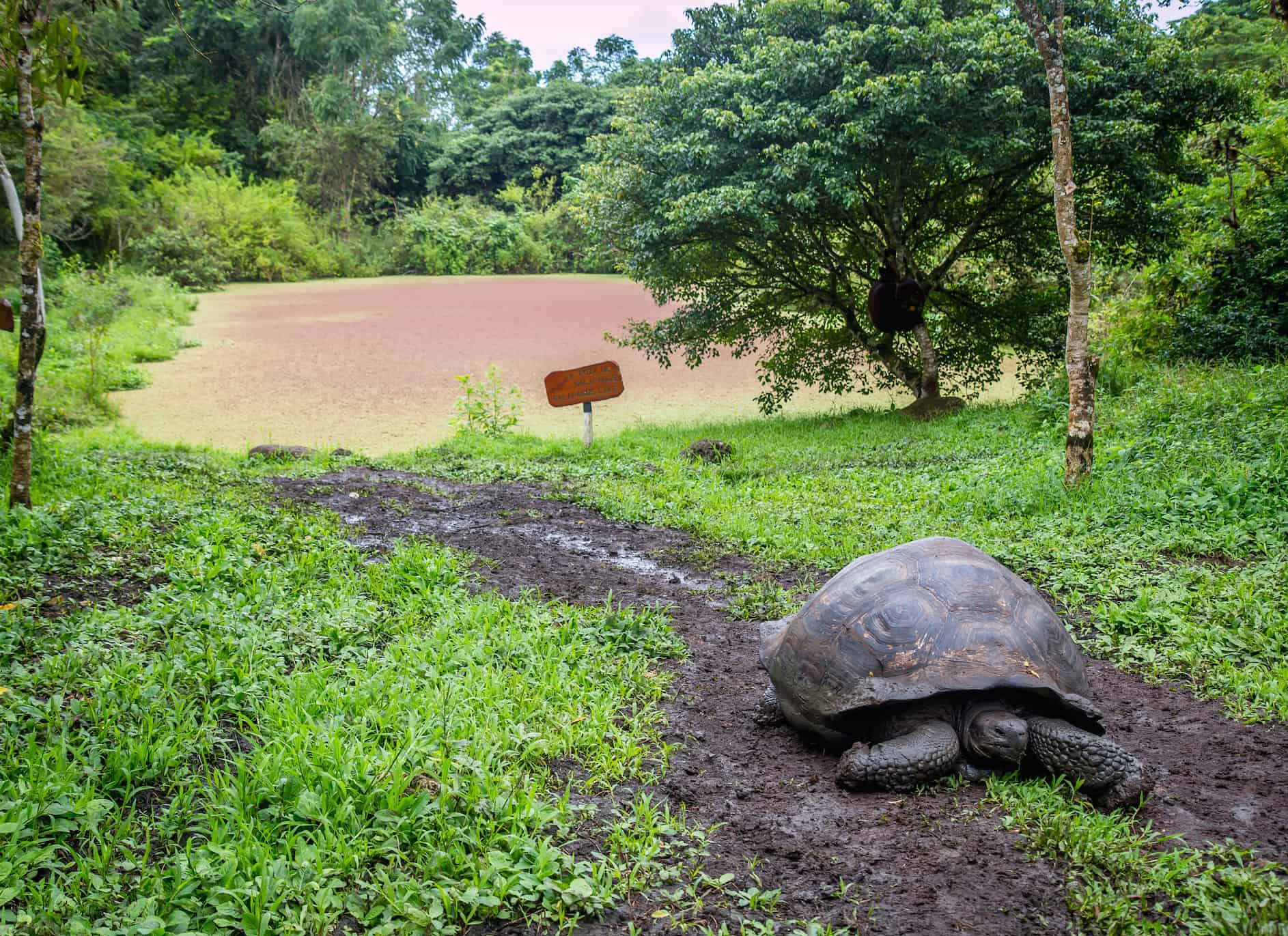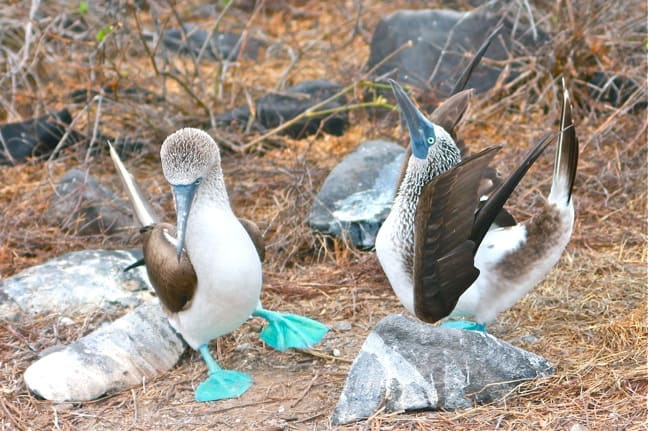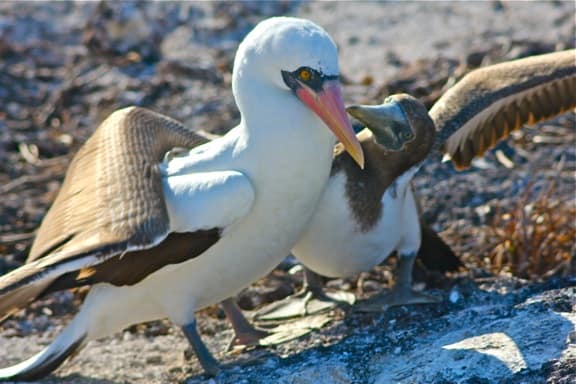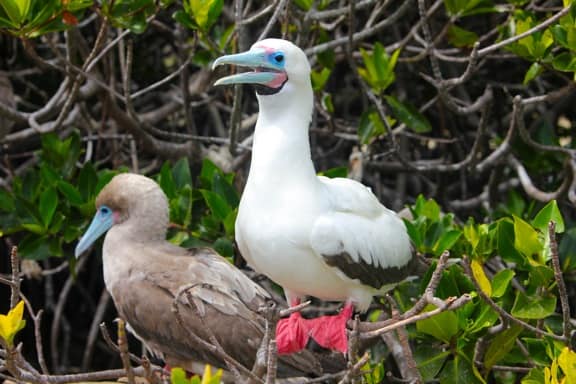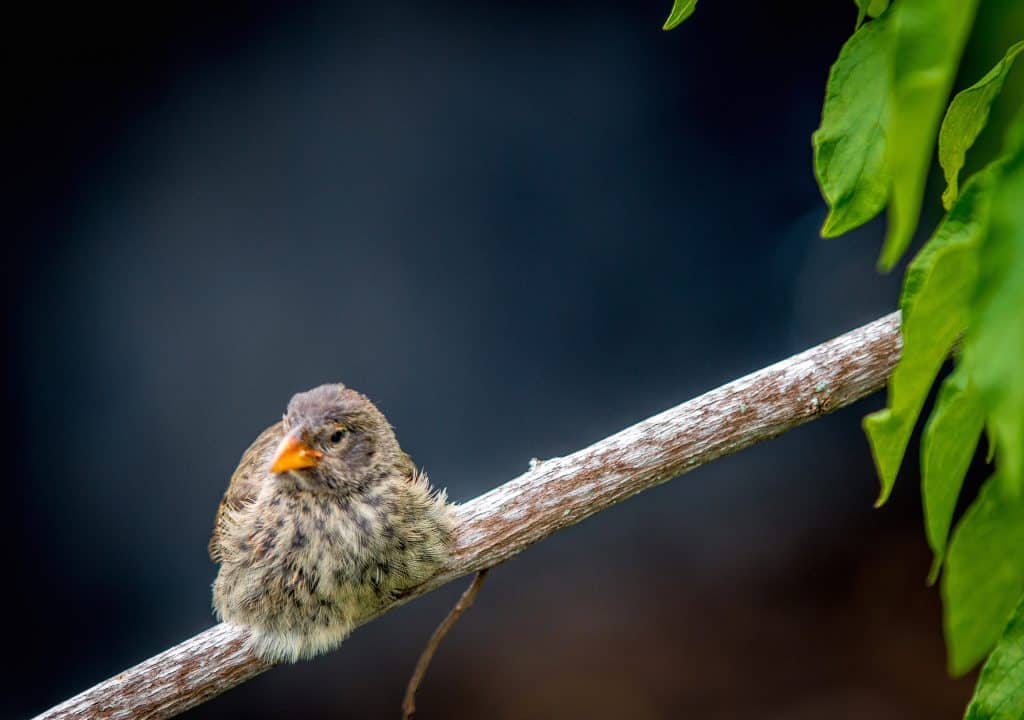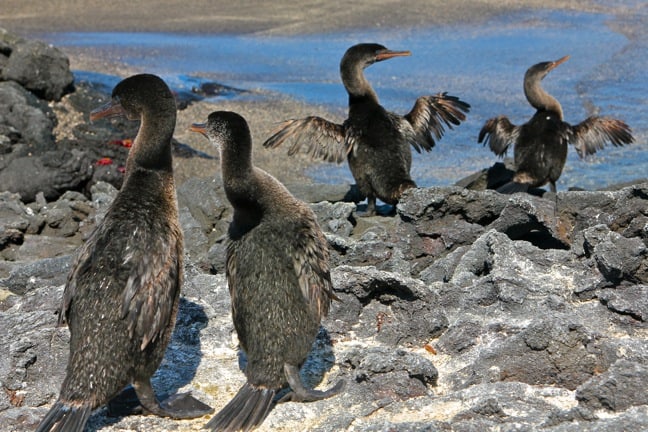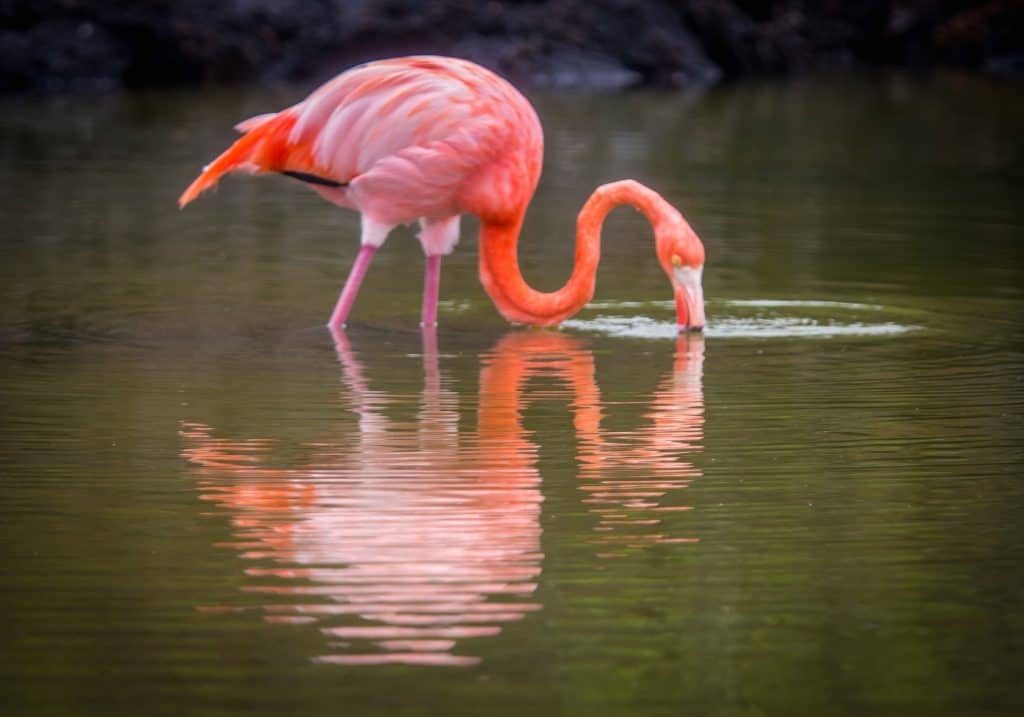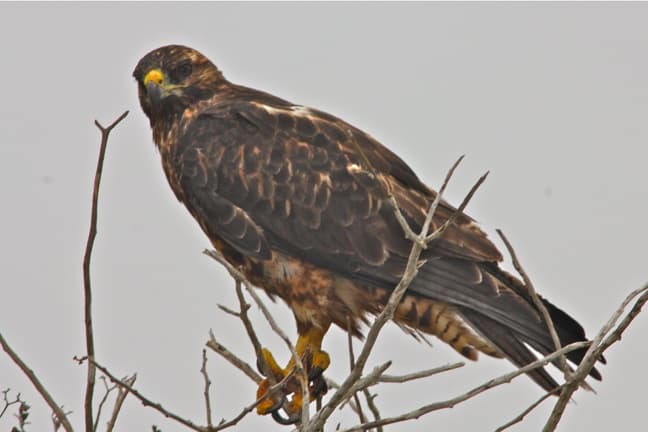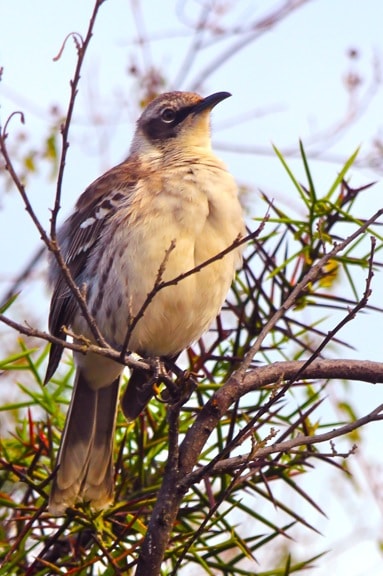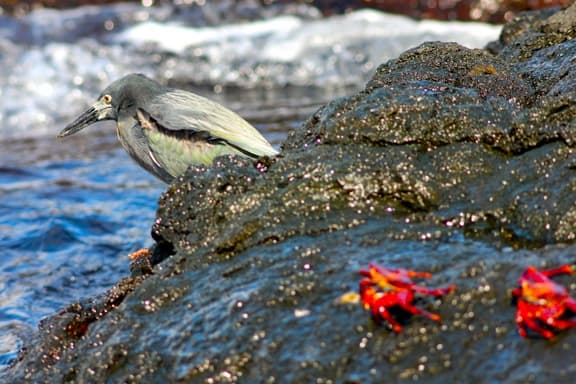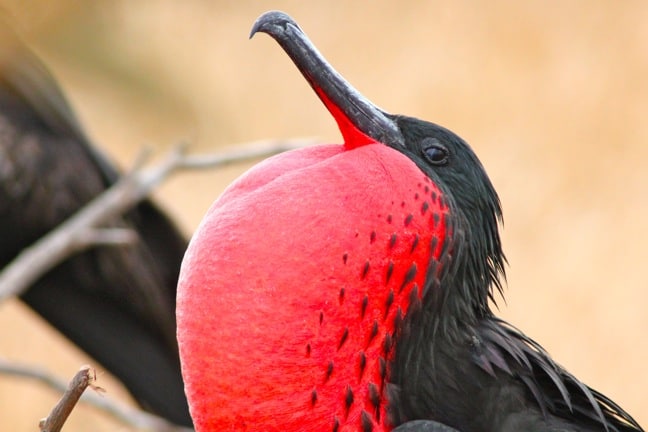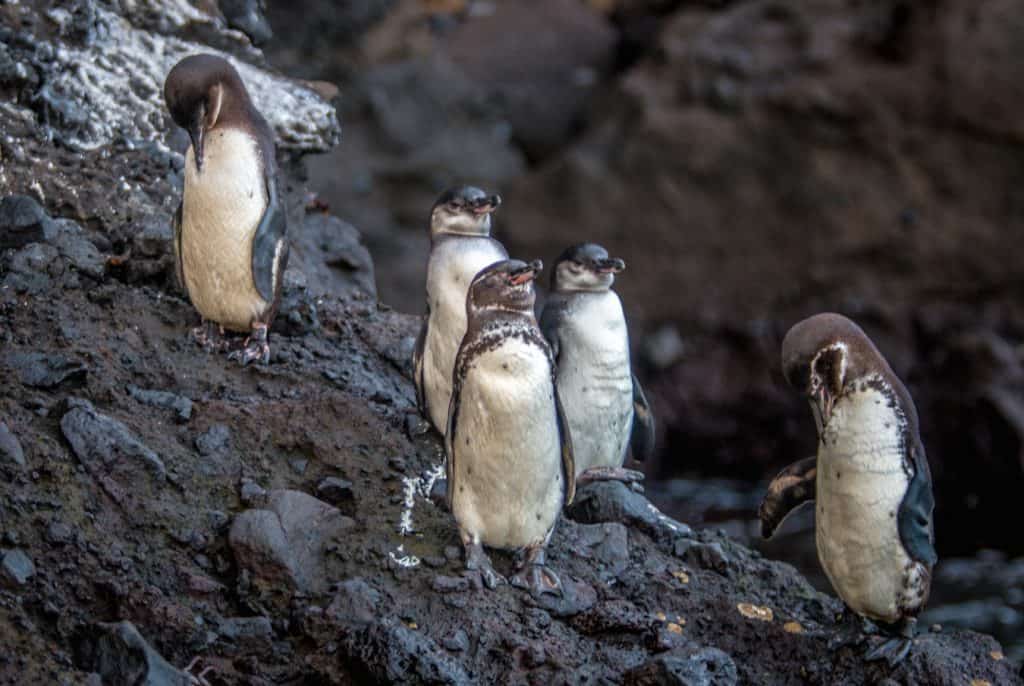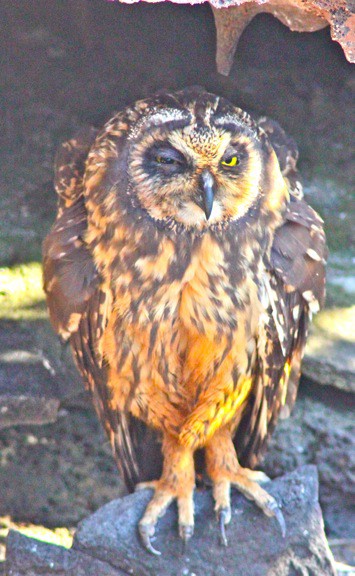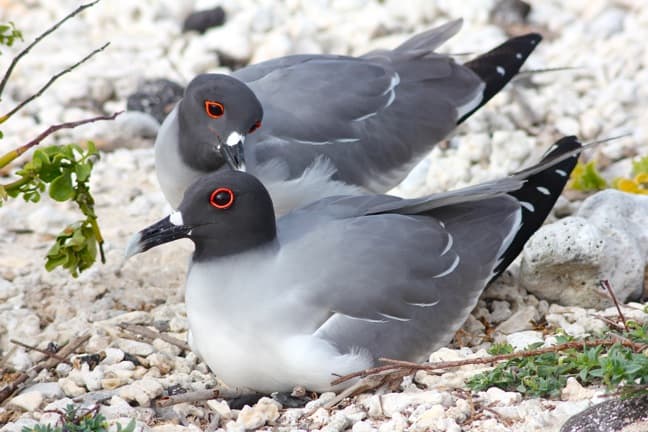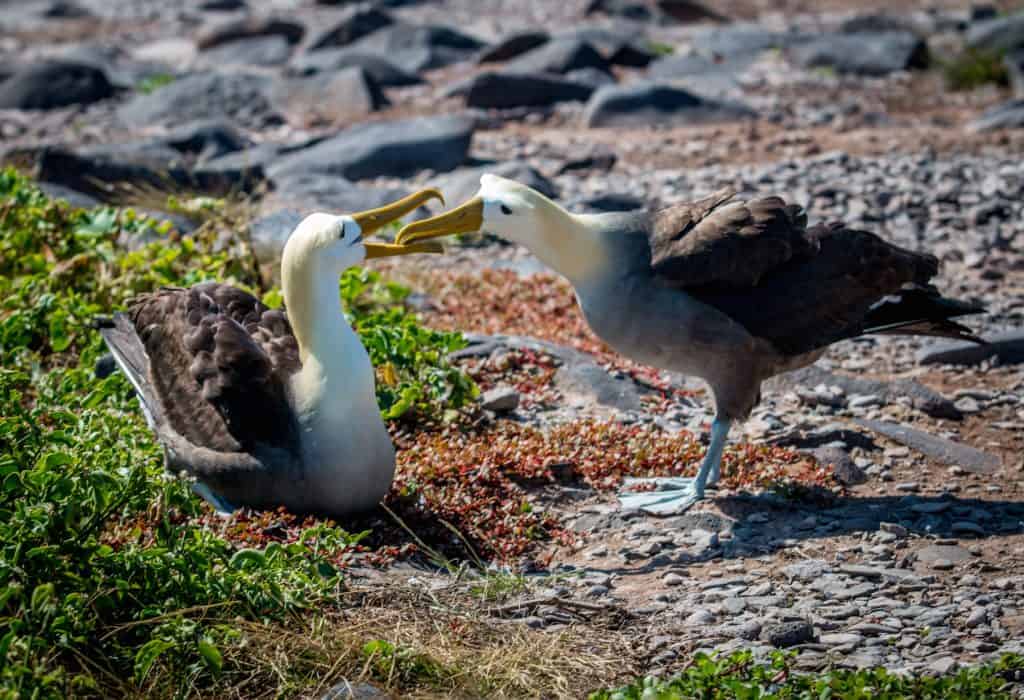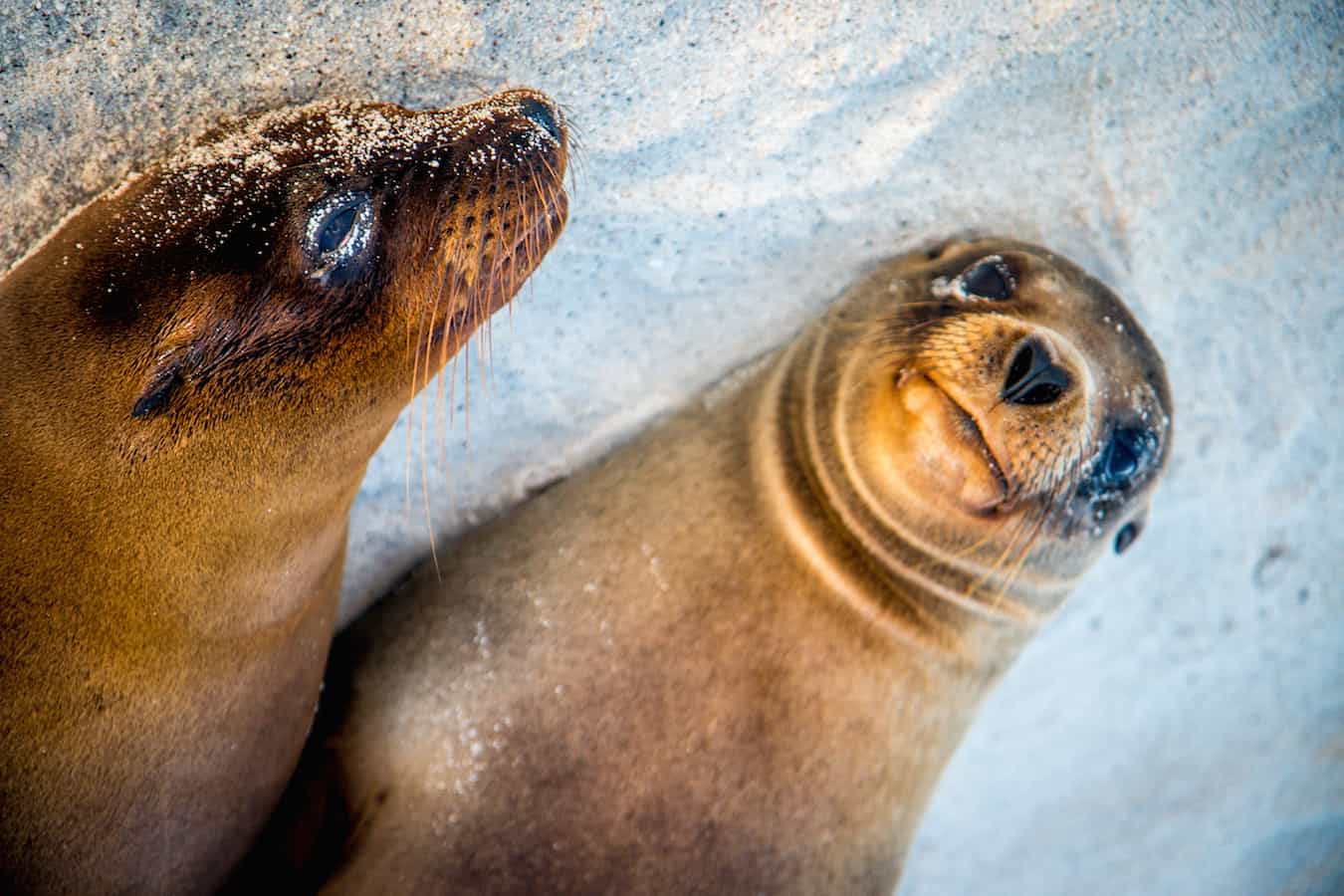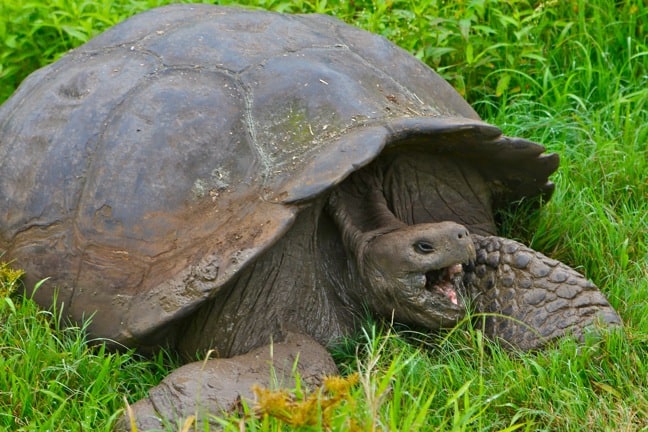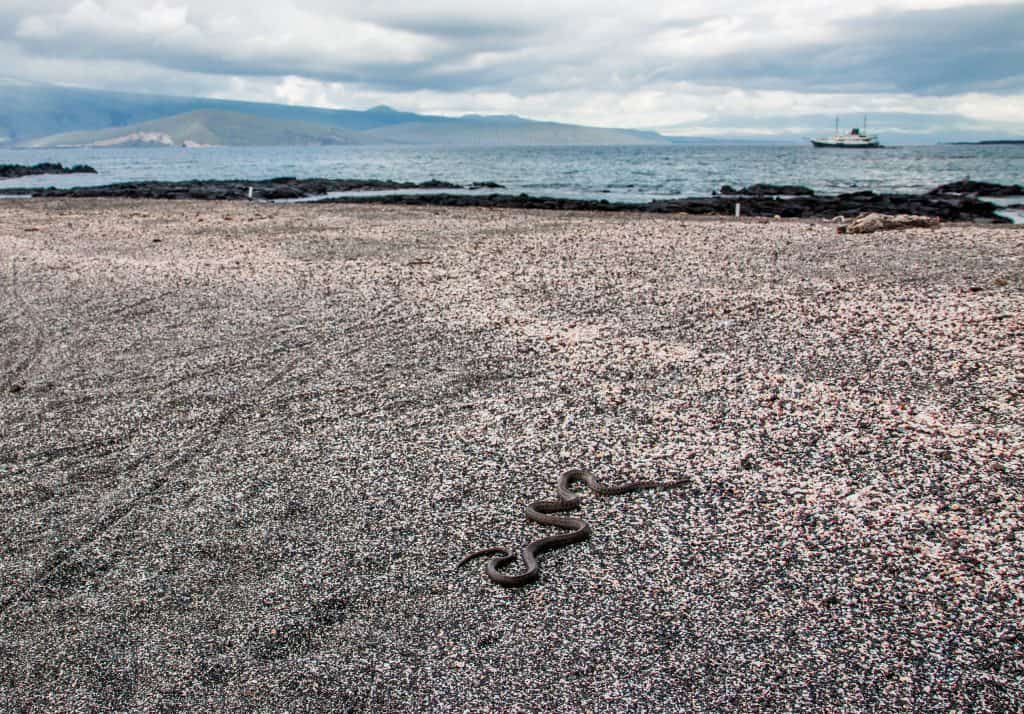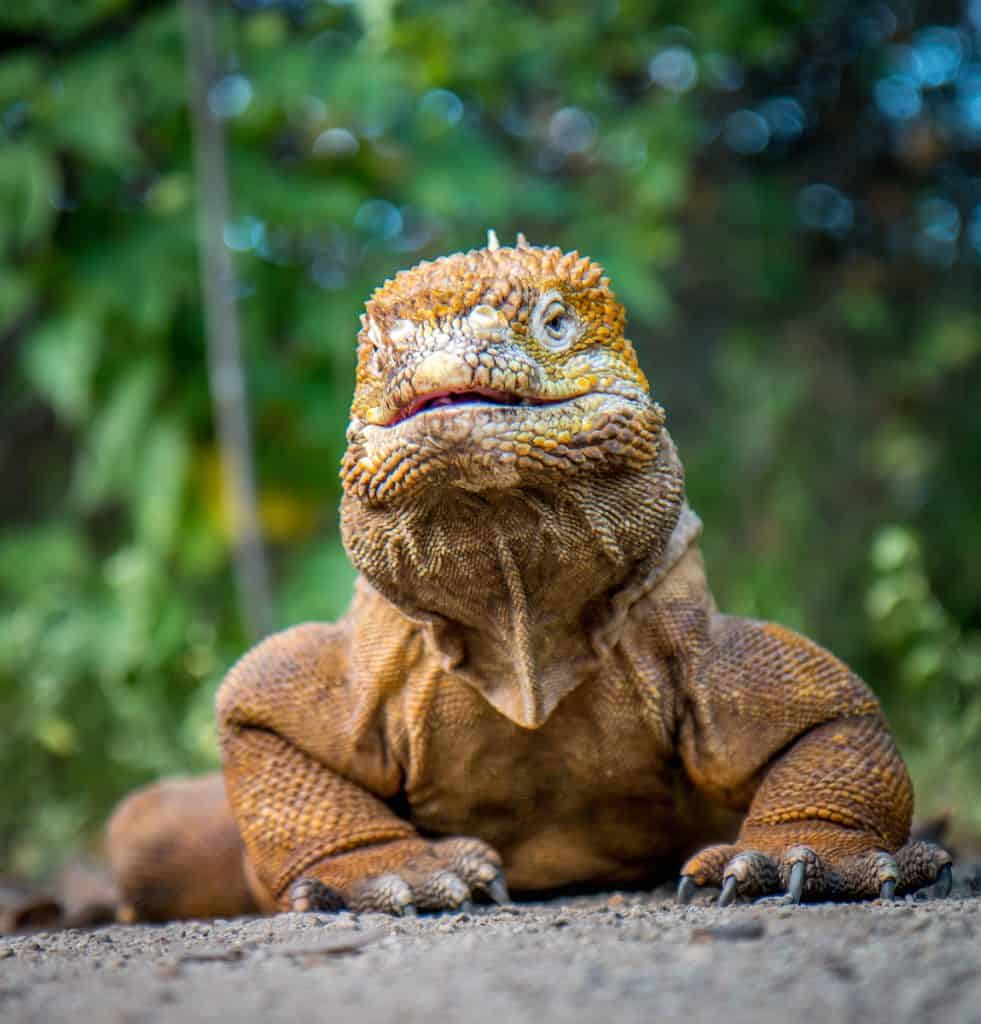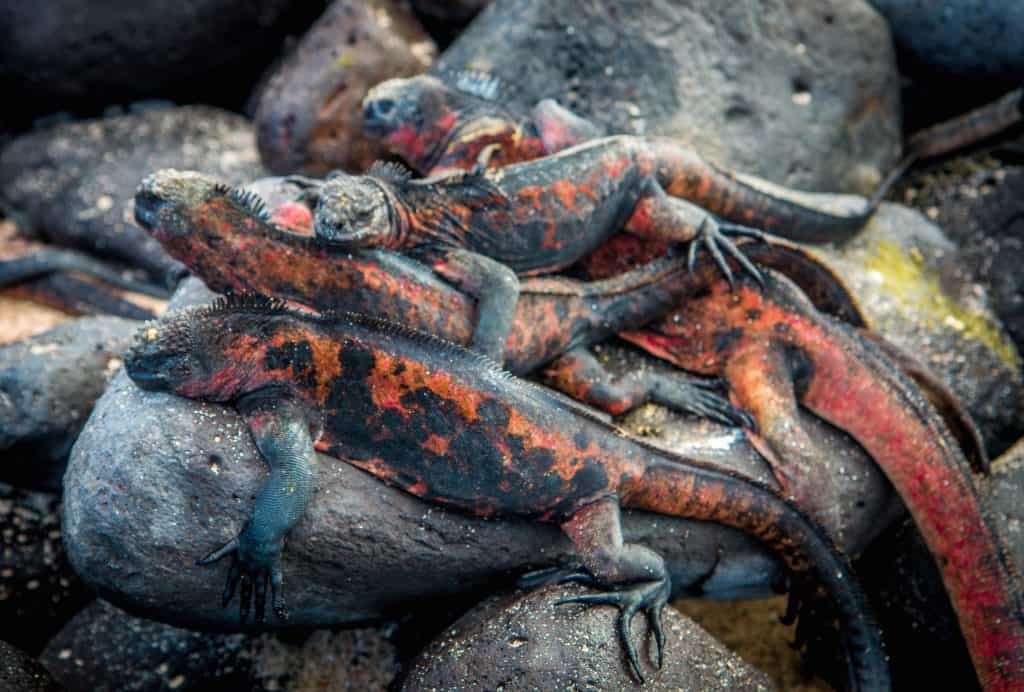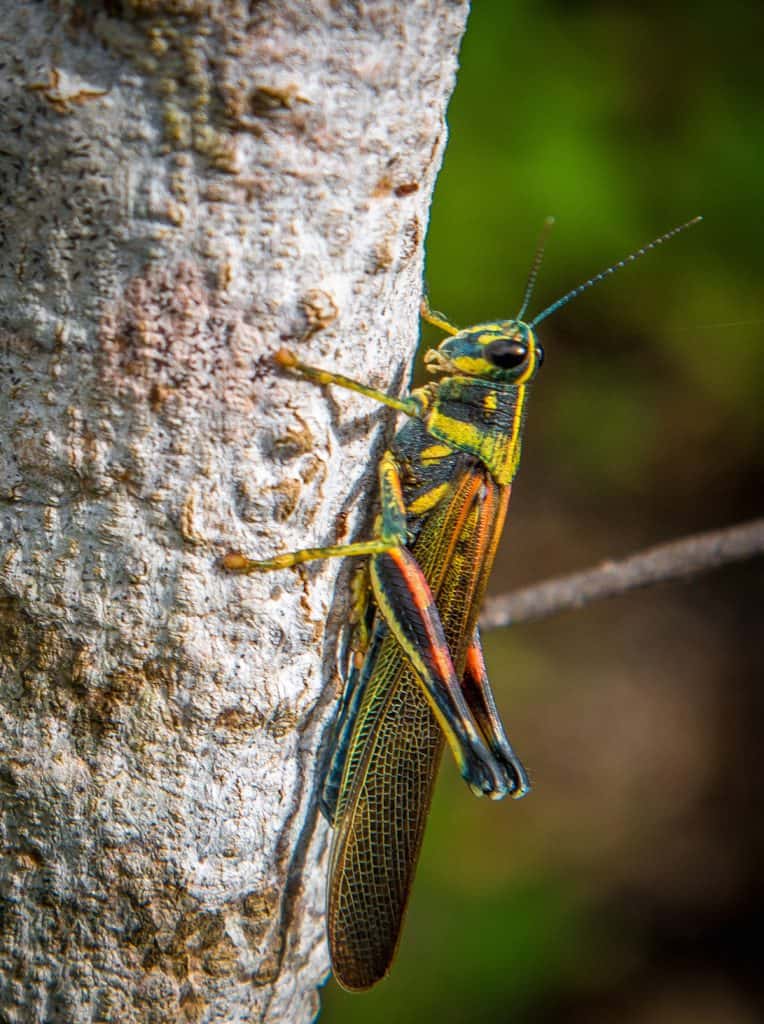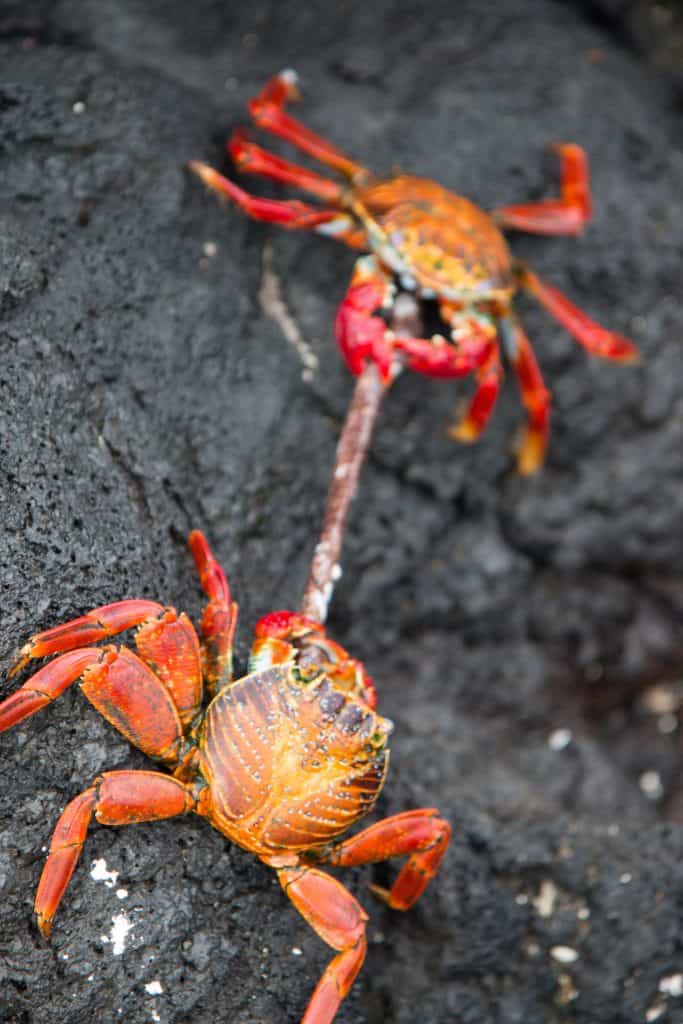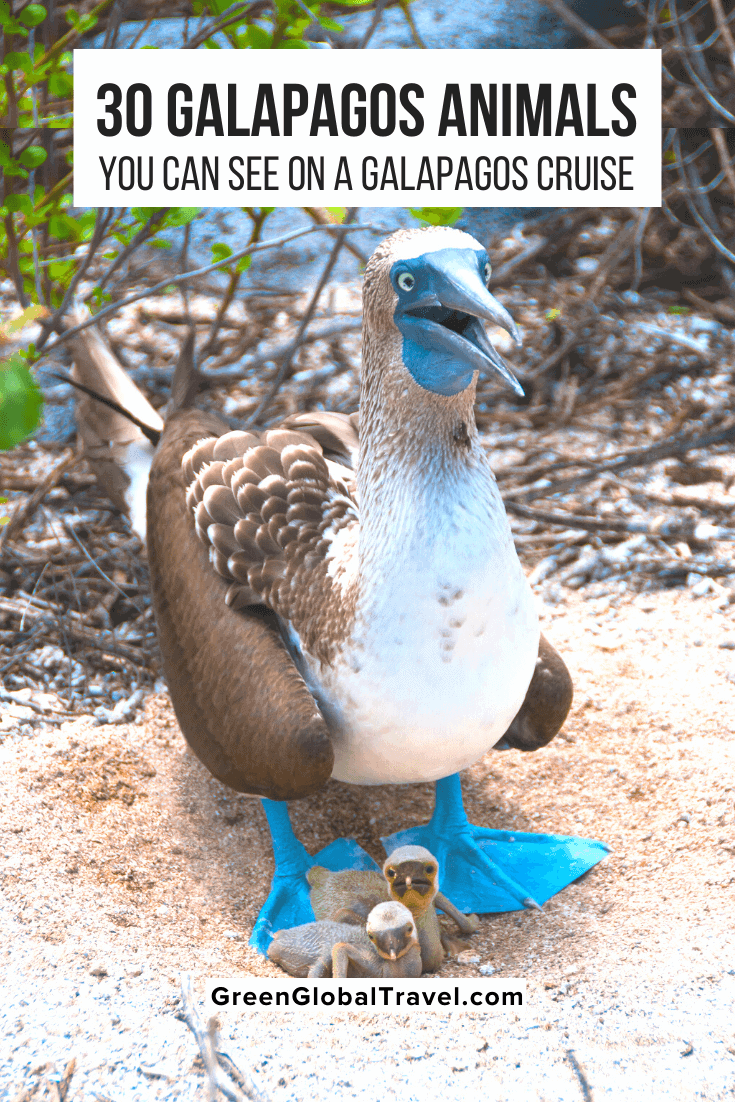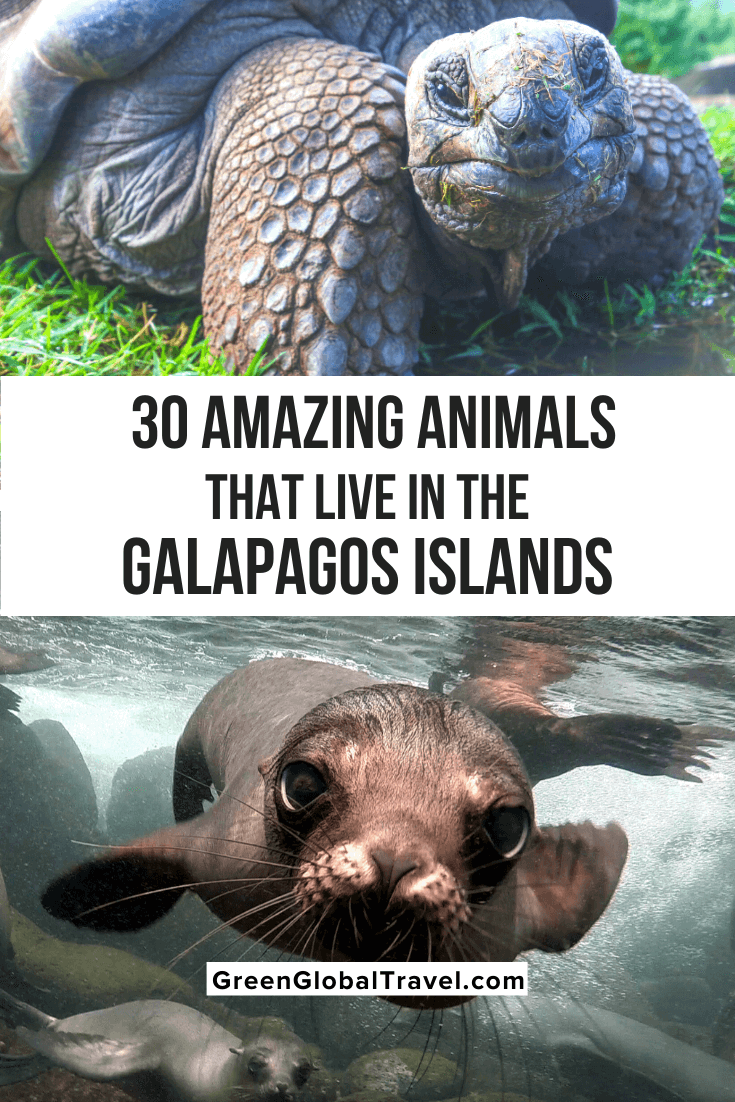[Updated 7/26/2022] In a rugged archipelago situated 600 miles off the coast of Ecuador, there are more than 200 recorded species of Galapagos Islands animals.
From a historical perspective, the islands’ remote location and harsh volcanic terrain played a huge role in their current status as a world-renowned nature sanctuary.
The islands were a favorite spot among pirates (who pillaged the Galapagos tortoise population for meat) and whalers (who plundered its waters for their ample bounty) in the 17th and 18th centuries.
But all efforts to colonize the area ended badly, and by the late 1800s the Galapagos Islands were widely considered cursed.
Most of the 13 major and 7 smaller islands remain uninhabited today, with over 97% of the archipelago preserved as a national park.
As a result of these conservation efforts, the Galapagos Islands remains one of the world’s most pristine and unspoiled UNESCO World Heritage Sites, with a remarkable array of mammals, reptiles, amphibians and bird species to be seen.
Here are some of our favorite Galapagos wildlife we saw during our trip with International Expeditions.
They include animals only found in the Galapagos Islands such as the Flightless Cormorant, Galapagos Flamingo, Galapagos Penguins, Darwin’s Finches, Marine Iguanas, and more.
READ MORE: 10 Eco Lessons in Quotes from The Lorax (Dr Seuss’ Conservation Classic)
GALAPAGOS ISLANDS ANIMALS GUIDE
- Blue-Footed Booby
- Nazca Booby
- Red-Footed Booby
- Galapagos Finches
- Galapagos Flightless Cormorant
- Galapagos Dove
- Galapagos Flamingo
- Galapagos Flycatcher
- Galapagos Hawk
- Galapagos Mockingbird
- Lava Gull
- Lava Heron
- Magnificent Frigate
- Galapagos Penguins
- Short-Eared Owl
- Swallow-Tailed Gull
- Galapagos Albatross
- Galapagos Fur Seal
- Galapagos Sea Lion
- Galapagos Hoary Bat
- Red Bat
- Galapagos Tortoise
- Galapagos Islands Snakes
- Galapagos Land Iguana
- Galapagos Marine Iguana
- Galapagos Pink Land Iguana
- Galapagos Lava Lizard
- Painted Locust
- Galapagos Shark
- Galapagos Batfish
- Sally Lightfoot Crab
GALAPAGOS ISLAND BIRDS
1. Blue-Footed Booby
Latin Name: Sula nebouxii
Habitat: Tropical/Subtropical islands in Pacific Ocean
Size: 32 to 34 inches, 3.4 pounds
Diet: Fish, sardines, anchovies, mackerel, squid
Conservation Status: Least Concern, population stable
The three booby species rank among the most popular birds of the Galapagos Islands, and the Blue-Footed Booby was easily our favorite.
They typically feed close to shore, making spectacular dives into the sea to catch fish, and are widely distributed in small ground-nesting colonies.
The Blue Footed Booby Dance is an elaborate mating ritual, with stampy-feet and a pose known as “skypointing,”.
I actually missed the unusual display due to a serious bout of seasickness, but Mary captured this incredible shot.
READ MORE: 25 Birds of the Galapagos Islands
2. Nazca Booby
Latin Name: Sula granti
Habitat: Galapagos/Malpelo Archipelagos, Pacific Coast of Central America
Size: 30 to 35 inches, 3 to 5 pounds
Diet: Small fish, squid
Conservation Status: Least Concern, population decreasing
The Nazca Booby, which was formerly known as a Masked Booby due to distinctive facial markings, is known for committing siblicide.
Nazca Boobies lay two eggs, but the oldest chick typically kills the youngest.
Here, the surviving offspring encourages his mom to regurgitate a meal of fresh fish, which they catch by diving into the water with incredible speed and velocity.
READ MORE: 21 Fascinating Facts About the Galapagos Islands
3. Red-Footed Booby
Latin Name: Sula sula
Habitat: Tropical/Subtropical Atlantic, Pacific, Indian Oceans
Size: 2.1 to 2.5 feet, 2-3 pounds
Diet: Small fish, squid
Conservation Status: Least Concern, population decreasing
The Red-Footed Booby is the smallest and most abundant of the three different booby bird species that are found in the Galapagos Islands.
As you can see from the photo above, they come in both a white and brown morph, but both have the characteristic-colored feet.
Red-Footed Boobies typically nest in trees and shrubs on the outer-most islands, because they prefer to feed far out to sea.
There, they make spectacular dives to prey on small fish or squid spotted on the water’s surface.
The best place to see them is near the horseshoe-shaped beach on Genovesa Island, which is aptly nicknamed “Bird Island” for the huge colonies you’ll find there.
READ MORE: 35 Beautiful Birds of Hawaii and the Polynesian Triangle
4. Galapagos Finches
Latin Name: Geospiza magnirostris
Habitat: Galapagos Islands
Size: 10 to 20 cm, .2 to 1.4 ounces
Diet: Opuntia cacti, fruits, vegetation
Conservation Status: Endangered, population decreasing
The 14 species of Darwin’s Finches (a.k.a. Galapagos Finches) belong to the tanager family and are not closely related to true finches.
They played a crucial role in Charles Darwin’s theory of natural selection, as each Galapagos species has a distinctive beak size and shape and specialized feeding behavior.
Collectively, they fill the roles of some seven different families of birds that are found on mainland South America.
READ MORE: Beautiful European Birds: A Guide to 10 Endemic Species
5. Galapagos Flightless Cormorant
Latin Name: Phalacrocorax harrisi
Habitat: Galapagos Islands
Size: 35 to 40 inches, 5.5 to 11 pounds
Diet: Eels, octopus, fish
Conservation Status: Vulnerable, population stable
The Flightless Cormorant ranks among the world’s rarest bird species, with less than 1000 left in the Galapagos Islands.
It’s definitely an odd bird, with black and brown feathers, turquoise eyes, growling voices, and wings about 1/3 the size that would be required in order for the bird to fly.
Their feathers aren’t waterproof, so they spend a lot of time drying them in the sunlight.
They’re found only on Fernandina and Isabela Islands, where you frequently see them diving in search of fish, eels and other small prey.
READ MORE: VIDEO: Flightless Cormorants Mating Dance
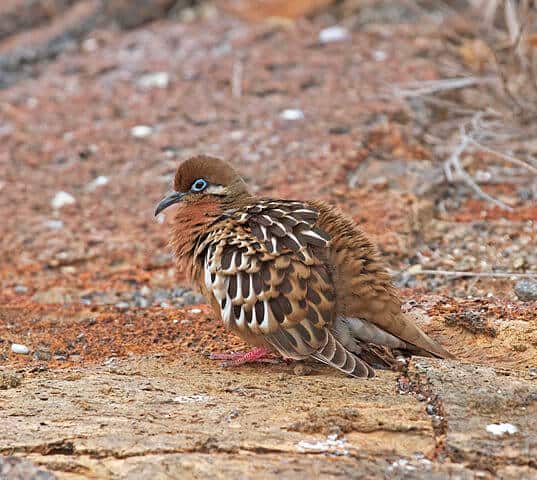
6. Galapagos Dove
Latin Name: Zenaida galapagoensis
Habitat: Subtropical forests and shrublands in the Galapagos Islands
Size: 7 to 9 inches, 2.3 to 3.3 ounces
Diet: Caterpillars, flowers, cacti, seeds, fruits
Conservation Status: Least Concern, population stable
The Galapagos dove isn’t the most rare or endangered bird in the Galapagos. They’re pretty common, especially in the archipelago’s arid lowlands.
But they are native to the islands and intriguing: Whenever their nests are in danger, the adults will feign injury in order to lure the would-be invader away.
They also perform a unique bee-like function, helping to pollinate the Opuntia Cactus upon which they like to feed.
In terms of appearance, they’re not unattractive either. They have reddish-brown upper parts, pink neck and breast, buff-colored belly, and brown wings streaked with white and black.
They also have a distinctive downward-curved beak for feeding on ground fruits and seeds.
READ MORE: 25 Beautiful Birds in the Amazon Rainforest
7. Galapagos Flamingo
Latin Name: Phoenicopterus ruber
Habitat: Shallow waters, coastlines Galapagos / Archipelago of Ecuador
Size: 43 to 59 inches, 4.4 to 8.8 pounds
Diet: Crustaceans, water plants
Conservations: Least Concern
The Galapagos Flamingo is the world’s smallest flamingo species.
With around 350 left in the wild, they’re listed as Endangered by the IUCN, and are one of the most endangered of all Galapagos Islands animals.
They can usually be found in saltwater lagoons near the sea, feeding on the brine shrimp whose aqueous bacteria and beta carotene give them their pink color.
Where populations elsewhere require large groups for successful breeding, Galápagos Flamingos can breed with just a few pairs present, producing chicks with grey plumage.
READ MORE: The World’s Best Small Ship Cruises
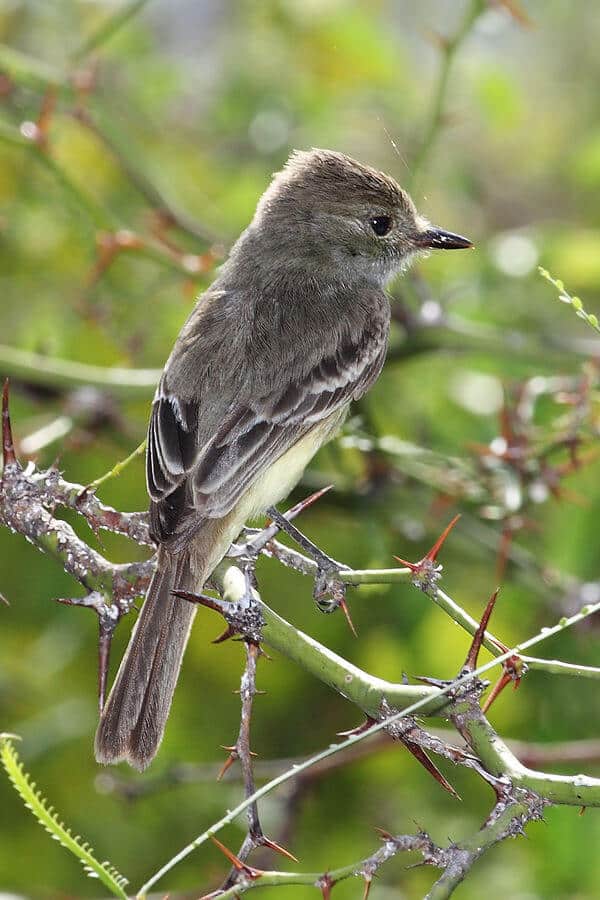
8. Galapagos Flycatcher
Latin Name: Myiarchus magnirostris
Habitat: Tropical forests / shrubland of Galapagos Islands
Size: 5.9 to 6.3 inches, .4 to .66 ounces
Diet: Insects
Conservation Status: Least Concern, population decreasing
Also known as the Large-billed Flycatcher or Papamoscas, this beautiful bird is the smallest species in its genus. It’s also the only Flycatcher found in the Galapagos Islands.
It measures around 6 inches long, with a slight bushy crest and drab grey plumage offset by yellow bellies.
They’re commonly seen on the main islands in the archipelago, living in tropical dry forests and arid scrub near cacti.
This is a bold, curious bird that’s known for perching on visitors and/or their cameras.
Some experts believe they are attracted to the reflection of themselves in the lenses, believing it to be another bird.
READ MORE: 20 Beautiful Birds of North Carolina
9. Galapagos Hawk
Latin Name: Buteo galapagoensis
Habitat: Shoreline / Deciduous forest / Galapagos Islands
Size: 18 to 23 inches, 1.8 to 3 pounds
Diet: Invertebrates, snakes, rodents, lizards
Conservation Status: Vulnerable, population stable
With few natural predators, the Galápagos Hawk plays a vital role in the archipelago’s ecosystem.
Similar in size to a red-tailed hawk, they use their sharp beaks and claws to prey on lizards, snakes, rodents, marine iguanas and the occasional turtle hatchling.
They also feast on carrion, even that which is too rancid for other animals to eat.
READ MORE: 20 Beautiful Birds of Georgia
10. Galapagos Mockingbird
Latin Name: Mimus parvulus
Habitat: Coastal shrubland, lowland, Galapagos Islands
Size: 9 to 10 inches, 51 to 56 grams
Diet: Seeds, invertebrates, eggs, baby turtles
Conservation Status: Least Concern, population stable
The long-tailed, long-legged, long-beaked Galapagos Mockingbird is a relatively common sighting, with six endemic subspecies spread across the archipelago.
The omnivore eats almost anything– seeds, eggs, fruit and more– and helps to distribute viable seeds across the islands after digesting them.
READ MORE: Arctic Animals: 30 Species of Arctic Birds, Mammals & Whales
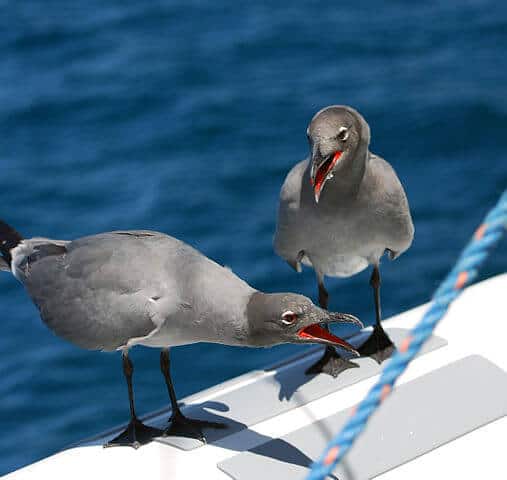
11. Lava Gull
Latin Name: Leucophaeus fuliginosus
Habitat: Beaches / Coastlines of Islands (Galapagos)
Size: 20 to 22 inches, 13 ounces
Diet: Fish, crustaceans, lizards, turtles, iguanas
Conservation Status: Vulnerable, population increasing
Also known as the Dusky Gull, the Lava Gull is currently considered the rarest gull in the world, with an estimated 300-500 individuals left.
Part of the “hooded gull” group, it is most closely related to the Franklin’s Gull and Laughing Gull.
It measures around 20 inches long and weighs 13 ounces, with dark grey wings whose white lined edges are believed to help with camouflage.
The highly territorial, solitary nesters are most commonly seen on Genovesa Island, Isabela Island, San Cristobal Island, and Santa Cruz Island.
READ MORE: The 30 Best Exotic Islands to Visit
12. Lava Heron
Latin Name: Butorides striata
Habitat: Lava rock coastlines, saltwater lagoons, mangrove forests
Size: 35 centimeters, 190 to 235 grams
Diet: Small crabs, fish
Conservation Status: Least Concern, population decreasing
This gorgeous grey-green guy, also known as the Galápagos heron, is one of the archipelago’s endemic bird species.
It was formerly lumped in with the Green Heron and is considered by some experts (including BirdLife International) to be a subspecies of the Striated Heron.
But it is officially considered a distinct species, Butorides sundevalli.
I had an excellent time watching this one on the shores of Fernandina Island as it stalked fish and Sally Lightfoot Crabs, spearing them with his sharp beak at lightning speed.
They’ve also been known to eat flies buzzing around the islands’ cacti.
READ MORE: What is Ecotourism? (The History & Principles of Responsible Travel)
13. Magnificent Frigate
Latin Name: Fregata magnificens
Habitat: Coastlines, Tropical/Subtropical oceans, mangrove cays
Size: 35 to 45 inches, 35.3 to 67 ounces
Diet: Flying fish, fish, plankton, crabs, jellyfish
Conservation Status: Least Concern
The Magnificent Frigate is not endemic to the Galapagos, but it is one of its area’s most impressive inhabitants.
With bodies up to 45 inches long and a massive wingspan, they can usually be seen soaring aloft (often on wind currents created by boats), never touching the water.
They feed by either snatching fish from the ocean’s surface or forcing other birds to regurgitate their meal so they can steal it.
During mating season, males inflate their red throat pouches dramatically to attract females, which makes for dramatic, colorful photos.
READ MORE: 40 Green Travel Tips (The Ultimate Guide to Sustainable Travel)
14. Galapagos Penguins
Latin Name: Spheniscus mendiculus
Habitat: Galapagos Islands
Size: 19 to 21 inches, 5.5 pounds
Diet: Small fish
Conservation Status: Endangered, population decreasing
Galapagos Island Penguins are mostly seen on Fernandina and Isabela, where fewer than 1,000 breeding pairs remain.
Measuring just 19 inches long and weighing 5 pounds, these tiny Galapagos penguins have genetically adapted to the heat (59º-82ºF).
They regulate their body temperature by stretching out their flippers, avoiding the sun, panting and swimming in the islands’ cool waters.
READ MORE: VIDEO- Secrets to Swimming with Galapagos Penguins
15. Short-Eared Owl
Latin Name: Asio flammeus
Habitat: Marshes, bogs
Size: 13 to 17 inches, 7.3 to 16.8 ounces
Diet: Small mammals, birds, rats, bats, rabbits
Conservation Status: DATA DEFICIENT
These birds of prey are named for the tufts of feathers they have, which look a bit like the ears of mammals. The ears aren’t usually visible, as they’re displayed only when the owl strikes a defensive pose.
Measuring around 13-17 inches long, the Short-eared Owl boasts beautiful plumage, mottle tawny and brown with a barred tail and wings. Their flight pattern is oddly irregular, more like a moth or bat than other birds.
They’re most often seen in open country and grasslands. But our guide was delighted to spot this one resting in the crevice of a seaside cliff formation on the island of Genovesa.
READ MORE: Top 15 Female Wildlife Conservationists & Animal Rights Activists
16. Swallow-Tailed Gull
Latin Name: Creagrus furcatus
Habitat: Steep, Rocky Slopes of Galapagos islands
Size: 20 to 22 inches, 22 to 28 ounces
Diet: Fish, squid
Conservation Status: DATA DEFICIENT
The endemic Swallow-Tailed Gull is the only fully nocturnal seabird in the entire world.
Mating pairs of these beautiful birds will nest on steep slopes, ledges, and beaches, frequently staying together and breeding year after year.
Their red-ringed eyes are a striking, defining feature.
READ MORE: Top 20 National Forests in America for Camping & Hiking
17. Galapagos Albatross
Latin Name: Phoebastria irrorata
Habitat: Galapagos Islands
Size: 31 to 35 inches, 7.4 pounds
Diet: Squid, fish, crustaceans
Conservation Status: Critically Endangered, population decreasing
Classified as Critically Endangered due to their small breeding range, the Galapagos Waved Albatross is only found on Española Island.
Pairs usually mate for life, typically arriving in late March and doing an elaborate mating dance to ensure they have the right partner.
During non-breeding season, they move to the waters off the coast of Ecuador and Peru.
READ MORE: 40 Fascinating Facts about the Hawaiian Goose (a.k.a. Nene Goose)
GALAPAGOS MAMMALS
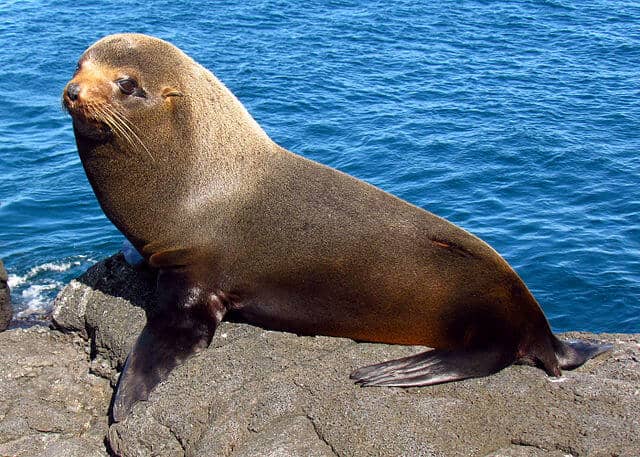
18. Galapagos Fur Seal
Latin Name: Arctocephalus galapagoensis
Habitat: Tropical islands / Galapagos Islands
Size: 4 to 5 feet, 87 pounds
Diet: Fish, squid, shellfish
Conservation Status: Endangered, population decreasing
Often confused with the plentiful Galapagos Sea Lions, the Galapagos Fur Seal is smaller and much less commonly seen.
Their thick fur ranges in color from dark brown to light gray color, and males are much larger than females.
Much like the Galapagos Penguin, these Fur Seals are experts in thermoregulation.
Research has shown that these animals sweat if they get too hot, but they can control their body temperature by instinctively regulating the flow of blood to their flippers.
While the Sea Lions seem to love the water more than just about anything, Fur Seals diving their time on land and in water fairly equally.
You won’t often see them on the sandy shores of Galapagos beaches, so look for them lazing about on rocks near the water.
READ MORE: Animals in Kenya: A Guide to 40 Species of Kenyan Wildlife
19. Galapagos Sea Lion
Latin Name: Zalophus wollebaeki
Habitat: Rocky shorelines, beaches / Galapagos Islands
Size: 59 to 98 inches, 110 to 880 pounds
Diet: Fish, squid, octopus, crustaceans
Conservation Status: Endangered, population decreasing
The Galapagos Sea Lion is listed by the International Union for the Conservation of Nature as an Endangered Species.
But you wouldn’t know it from touring the islands, where these curious cuties are practically everywhere.
They seem really awkward on land, with a lurching side-to-side gait, loud barks and an array of bizarre noises.
But in the water– where we saw them nearly every time we snorkeled– Galapagos Sea Lions transform into elegant and engaging acrobats.
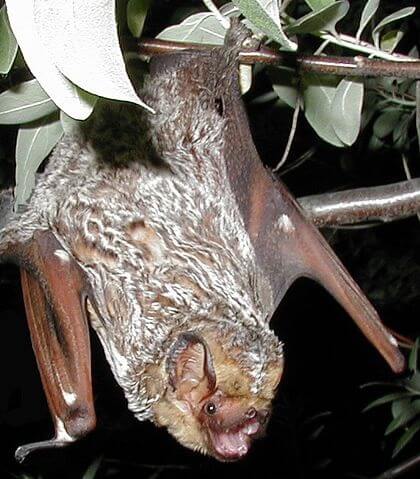
20. Galapagos Hoary Bat
Latin Name: Lasiurus cinereus
Habitat: Coniferous forests, caves / Galapagos Islands
Size: 5 to 5.7 inches, .9 ounces
Diet: Flies, beetles, small wasps, termites, dragonflies
Conservation Status: DATA DEFICIENT
The Hoary Bat can be found widely throughout much of North and South America.
But the ones you’ll see in the Galapagos are a disjunct population, which means they’re related but also separated.
It’s a fairly large bat, measuring up to 5.7 inches long, with a 15-inch wingspan. It’s named for its dense, dark brown coat of fur, which has frosty white tips on the hairs.
They usually roost alone on trees, hidden by foliage, but can occasionally be found in cave colonies with other bats.
READ MORE: 40 Amazing Costa Rica Animals
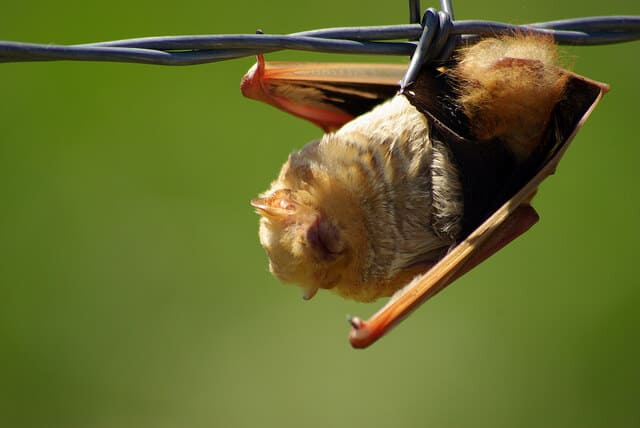
21. Red Bat
Latin Name: Lasiurus borealis
Habitat: Deciduous forests, coniferous forests
Size: 3.5 to 4.5 inches, .43 ounces
Diet: Beetles, moths, ants, other insects
Conservation Status: Least Concern, population stable
The Galapagos Red Bat is a subspecies of the Southern Red Bat, which is found in North and South America.
But where the Southern Red Bat migrates with the seasons, its Galapagos cousin is believed to remain relatively sedentary.
The Red Bat is the smallest of the Galapagos bat species, with rusty orange fur, red-frosted hindquarters, and a short, blunt head.
They’re nocturnal, spending most of the day roosting under leaves in the forest.
At night they come out to hunt a variety of insects, including moths, flies, true bugs, beetles and cicadas.
READ MORE: Indian Animals: A Guide to 40 Incredible Indian Wildlife Species
GALAPAGOS REPTILES
22. Galapagos Tortoise
Latin Name: Chelonoidis nigra
Habitat: Galapagos Islands
Size: 5 feet, 550 pounds
Diet: Prickly pear cactus, fruits, flowers, grasses
Conservation Status: Vulnerable
The prehistoric-looking Galapagos Tortoise can live over 150 years, and they’ve played an integral role in the history of the Galapagos Islands.
They were almost hunted to extinction, with numbers dwindling to around 3,000 in the 1970s.
But they were also a key influence on Darwin’s Theory of Evolution: Tortoises from different islands varied greatly in size and appearance, suggesting genetic adaptation to their respective environments.
Fortunately, Galapagos Conservation efforts have proven effective, and the tortoise population today has risen to around 20,000.
23. Galapagos Islands Snakes
Latin Name: Pseudalsophis biserialis or Philodryas biserialis
Habitat: Galapagos Islands
Size: up to 39 inches
Diet: Small reptiles, eggs, rodents, and bird hatchlings
Conservation Status: Near Threatened
There are three species of endemic snakes found in the Galapagos Islands.
The Galapagos Snake includes two subspecies– the Fernandina Snake seen above and the Isabela Snake– which are common on the islands for which they’re named.
Measuring up to 39 inches, they’re either brown with yellow stripes or dark grey with yellow spots forming a zigzag pattern.
Though mildly venomous, they’re primarily constrictors and relatively harmless to humans: One actually slithered right over the feet of a fellow traveler on our latest trip without incident.
READ MORE: Non-Venomous vs Venomous Snakes in North Carolina (ID Guide)
24. Galapagos Land Iguana
Latin Name: Conolophus subcristatus
Habitat: Dry areas of Galapagos Islands
Size: 3 to 5 feet, 25 pounds
Diet: Plants, shrubs, cactus
Conservation Status: Vulnerable
The vividly colorful Galapagos Land Iguana is arguably among my favorite animals of the Galapagos Islands.
Charles Darwin once described them as “ugly animals, of a yellowish orange beneath, and of a brownish-red color above: from their low facial angle they have a singularly stupid appearance.”
But we love their ancient brand of oddity, from the punky yellow spikes atop their seemingly smiling faces to the razor-sharp claws at the end of their massive feet.
READ MORE: 20 Best Caribbean Islands to Visit (If you Love Nature & Hate Crowds)
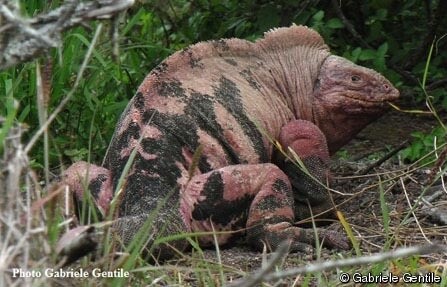
25. Galapagos Pink Land Iguana
Latin Name: Conolophus marthae
Habitat: Wolf Volcano, Isabela Island, Galapagos
Size: approx 3.6 feet, 11 pounds
Diet: insects, leaves, fruit, flowers
Conservation Status: Critically Endangered
Situated on the north end of Isabela Island, Wolf Volcano is the area’s tallest peak (5,600 feet), and erupted in 2015 after 33 years of inactivity.
What’s most interesting about the volcano is the fact that the wildlife around it is incredibly unique.
Not only from that of other islands in the archipelago, but from that of neighboring volcanoes on Isabela Island.
Among its most unique resident is the critically endangered Pink Land Iguana, which was first discovered in 1986 and identified as a distinct species in 2009.
With its pink body and dark stripes, this species is the only example of ancient diversification in the genus Conolophus (whose Latin name means “spiny crest”).
READ MORE: 70 Weird Animals from Around the World
26. Galapagos Marine Iguana
Latin Name: Amblyrhynchus cristatus
Habitat: Galapagos Islands
Size: 4 to 5 feet, 1 to 3.3 pounds
Diet: Algae
Conservation Status: Threatened
I’ve always thought that Galapagos Marine Iguanas look like little Godzillas, hissing and sneezing in order to expel excess salt from their nasal glands.
They tend to be found huddling together in clumps to warm themselves on the lava rocks.
They vary greatly from island to island in terms of size and color. You’ll see everything from teal green males on Española to the brick red colors of the subspecies on Fernandina.
There were so many iguanas there that you had to watch where you walked for fear of stepping on one!
But my favorite memory is of snorkeling the Galapagos and seeing Marine Iguanas feeding on algae on rocks 20 feet below us.
27. Galapagos Lava Lizard
Latin Name: Microlophus albemarlensis
Habitat: Lowlands, shorelines / Galapagos Islands
Size: Up to 1 foot
Diet: Moths, flies, beetles, ants, grasshoppers, plants
Conservation Status: Vulnerable
The lovely Galapagos Lava Lizard is another reptile with a seemingly friendly face.
There are six species endemic to the Galapagos, most of which grow to around 6 inches long.
The come in a beautiful range of colors, from mottled grey and green to speckled copper or black with gold stripes.
They’ve got no fear of humans and lots of personality and are frequently spotted close-up on most of the islands.
READ MORE: Ecotourism in Costa Rica: The Ultimate Eco Travel Guide
Painted Locust
Latin Name: Schistocerca melanocera
Habitat: Lowlands, islands
Size: 8 cm
Diet: Plants, grasses, leaves
Conservation Status: DATA DEFICIENT
Endemic to every Galapagos Island except Española, the large Painted Locust can grow to nearly 3.5 inches long.
Their vivid colors– yellow, orange, red and black– are intensely attractive.
But they don’t help much in terms of preventing them from being a favorite snack among Galapagos Hawks and Lava Lizards.
READ MORE: 25 Biggest Forests in the World (For Your World Travel Bucket List)
GALAPAGOS MARINE CREATURES

Galapagos Shark
Latin Name: Carcharhinus galapagensis
Habitat: Continental/Insular shelves
Size: 9.8 to 11 feet, 100 pounds
Diet: Eels, fish, squid
Conservation Status: Near Threatened
Commonly spotted around offshore islands in tropical areas around the world, this species can be difficult to differentiate from other reef sharks, such as the Dusky Shark and Grey Reef Shark.
Galapagos Sharks are dark grey on top with off-white bellies, black tips on their tails, and a ridge running between their dorsal fins.
The tall first dorsal fin is a distinguishing characteristic: It has a slightly rounded tip and starts over the rear tip of their pectoral fins.
They can grow up to 9 feet long, and feed primarily on bottom-dwelling fish, squid, and octopus.
Though large Galapagos Sharks can be aggressive, the smaller ones we have seen while snorkeling were among the most human-shy of all the Galapagos Islands animals.
Perhaps this is due to over-fishing and poaching for their fins, which– when combined with their slow reproductive rate– has landed the species on the IUCN’s Near Threatened list.
READ MORE: 30 Cool & Wierd Ocean Animals Around The World
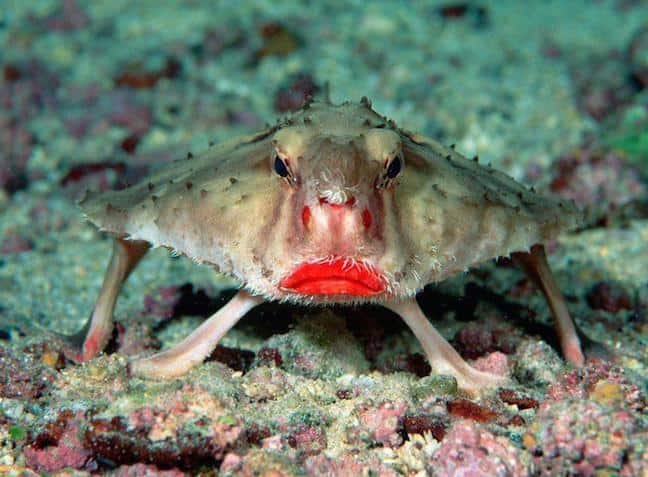
Galapagos Batfish
Latin Name: Ogcocephalus darwini
Habitat: Ocean Floors / Galapagos Islands
Size: 40 centimeters
Diet: Deep sea fish, crustaceans
Conservation Status: Least Concern
Also known as the Red-Lipped Batfish, this freaky-faced fish can be found only in the Galapagos Islands, usually at depths of anywhere from 10 to 250 feet.
In addition to its red lips, the fish (a terrible swimmer) is distinguished by its ability to “walk” on the ocean floor using its pectoral fins.
Once they reach maturity, their dorsal fin evolves into a single spine-like projection that they primarily use to lure prey, including crustaceans and other small fish.
The illicium on its head is used for the same purpose.
READ MORE: 55 Interesting Facts About Elephants (for World Elephant Day)
Sally Lightfoot Crab
Latin Name: Grapsus grapsus
Habitat: Coastlines, shorelines / Galapagos Islands / western coast of South and Central America
Size: 3 to 5 inches, .5 pounds
Diet: Algae, detritus, uneaten food, etc.
Conservation Status: UNKNOWN
One of the most common crabs found along the western coast of the Americas, this “Red Rock Crab” is more commonly known as the Sally Lightfoot Crab.
They’re a constant presence on the rocky volcanic shores of the Galapagos, skittering amongst the Sea Lions and Marine Iguanas to feed on algae.
They also eat feed on dead animals: These two were apparently fighting over what looked like an Octopus tentacle on the rocks of Fernandina Island.–by Bret Love; photos by Allie Love, Bret Love & Mary Gabbett unless otherwise noted
If you like our story on Galapagos Islands Animals, then you might also like:
7 Important Life Lessons I Learned in the Galapagos Islands
Q&A w/Swen Lorenz of the Charles Darwin Foundation
Darwin’s Paradise: A Galapagos Islands Adventure
DAY 1- Photo Gallery: San Cristobal, Kicker Rock & Genovesa
DAY 2- Photo Gallery: Genovesa Island & Fernandina Island
DAY 3- Photo Gallery: Isabela Island & Santiago Island
DAY 4- Photo Gallery: North Seymour Island & Bartolome Island
DAY 5- Photo Gallery: Santa Cruz Island & Espanola Island
Our Galapagos Islands trip was sponsored by International Expeditions. But our opinions always remain our own, and we will never compromise our obligation of integrity to our readers.

